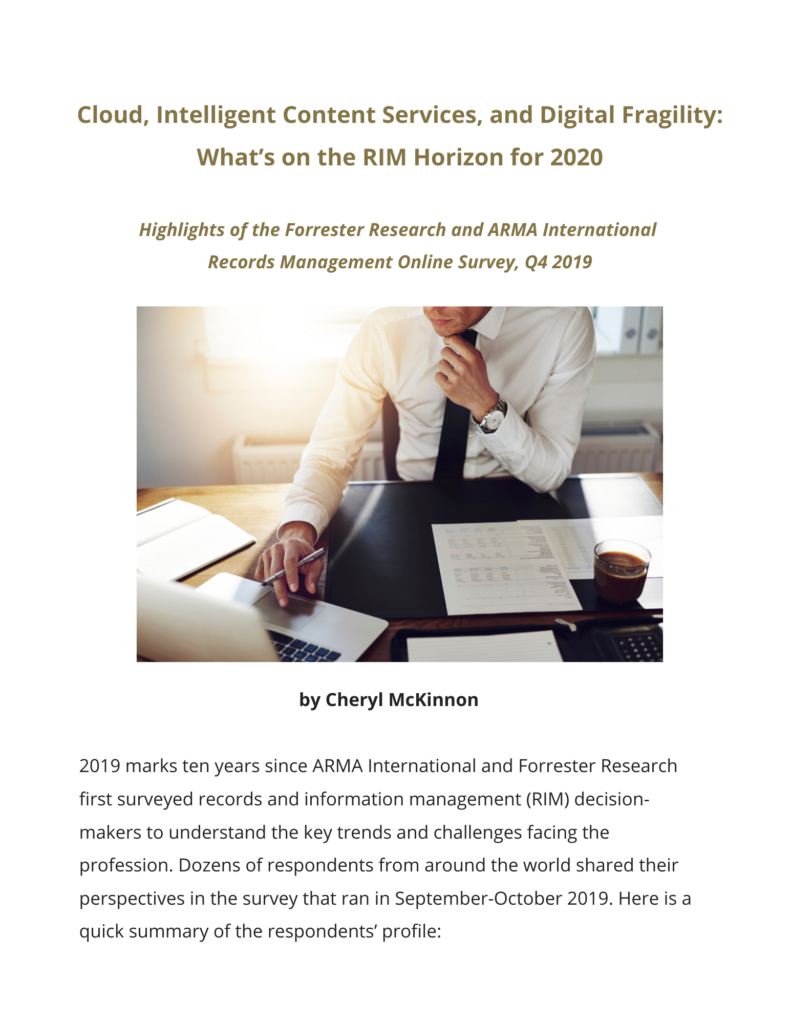Cloud, Intelligent Content Services, and Digital Fragility: What’s on the RIM Horizon for 2020

Highlights of the Forrester Research and ARMA International Records Management Online Survey, Q4 2019
2019 marks ten years since ARMA International and Forrester Research first surveyed records and information management (RIM) decision-makers to understand the key trends and challenges facing the profession. Dozens of respondents from around the world shared their perspectives in the survey that ran in September-October 2019. Here is a quick summary of the respondents’ profile:
- North America once again dominates the survey responses, with U.S. participants at 77% and Canada at 17%.
- Government topped the list of vertical industries at 23%.
- Large enterprise – over $1 billion in revenue or agency budget – was represented by 35% of respondents.
- Nineteen percent of RIM programs report into IT (up from 15% in 2017), and 28% into legal (up from 18.5% in 2017), with the remainder reporting into senior administrative roles, compliance, corporate services, or finance teams.
Information Governance Programs Still a Work-In-Progress
RIM professionals are instigating change in their organizations, and the pace of evolution is improving after a slip in 2017. In 2015, Forrester first posed the question “Have you restructured or re-organized your RIM and/or IT programs to support an information governance strategy?” Thirty-two percent of programs indicated they had done so. In 2017, only 25% of respondents reported they had re-organized their programs. For 2019, 34% of RIM professionals reported they had restructured their programs, with an additional 31% planning to do so into 2020.
Governance structures for RIM programs remain in flux. Twenty percent of survey respondents said they had “a steering committee of senior stakeholders” to guide decisions, however 22% have no governance structure at all (down slightly from 25% in 2017). Other responses include a center of excellence or dedicated program team (16%) and “multiple, coordinated cross-role committees” (11%). Eleven percent rely on legal to make decisions, with 2% letting IT run the show. Executive sponsorship for RIM programs continues to be influenced by legal, but a year-over-year decrease is noteworthy. In 2019, 25% report that the general counsel or most senior legal decision-maker is the key executive sponsor (down from 32% in 2017 and 41% in 2015).
Forrester notes that alignment of RIM and IT priorities may be slipping. Nineteen percent of RIM programs report into IT, consistent with 2017 and down slightly from 20% in 2015. Coordination of policies and priorities may have stalled. Two of the top three challenges selected by survey respondents continue to be stakeholder alignment and skills development, with 32% of respondents calling out the lack of stakeholder alignment among IT, legal, compliance, and business decision-makers as a top program challenge (up from 30% in 2017). Forty percent are challenged by the volume of unmanaged digital documents out of the RIM program’s control. Just 59% of surveyed RIM professionals are included in their company’s IT strategic planning, including activities such as requirements definition and vendor selection – down from 67% in 2017.
Digital Sprawl Continues to Plague RIM Professionals
The top challenge for RIM teams in 2019 is the same worry they had in 2017 and 2015. When asked “which of the following represent the top records management challenges for your organization,” the number one response, at 40%, was “the volume of unmanaged digital documents outside of RIM control,” which is up slightly from 39% in 2017. File shares, ungoverned SharePoint sites, mobile devices, and the growing volume of content in software-as-a-service (SaaS) applications mean that silos of corporate information are not only proliferating in corporate data centers but in cloud environments as well. Expect this digital sprawl to persist: Only 3% of survey respondents – down from 6% in 2017 – expect the volume of “non-record” documents to decrease over the next year, and less than 2% expect the volume of electronic records to decrease. In comparison, 52% expect the volume of on-site physical records to decrease (up slightly from 45% in 2017), along with 42% projecting a decrease in physical records held in third-party storage facilities (up from 32% in 2017).
Digital Records Are Finding Their Place in the Cloud
2019 shows continued comfort with cloud application for records management, building on the notable jump first seen in 2017. Hosted, cloud, or SaaS-based records management applications have been adopted by 32% of survey respondents, up from 30% in 2017 and 19% in 2015. A further 32% expect to use a cloud records management platform into 2020, up substantially from 18% in 2017. Just over a third at 37% have no plans to adopt the cloud in the foreseeable future, down notably from 52% in 2017.
The top objection to using the cloud for digital records continues to be potential privacy or security concerns – no change from 2017. Interestingly, the second-place objection is actual “policies, regulations or laws prevent[ing] this approach.”
Forrester also asked survey respondents using cloud records management, “what factors encouraged your organization’s adoption of SaaS, cloud or hosted records management solutions?” The top responses were cost-effectiveness and improved speed of adoption/deployment.
Intelligent Content Services and Automation: Must-Haves for 2020 Roadmaps
Artificial intelligence (AI) is the buzz-phrase of the year – but RIM professionals must research its real, practical opportunities while tuning out the hype. Vendors in the content management market are investing in intelligent content services. These include AI, machine learning (ML), and automated language translation or transcription services, provided by partnering with specialty vendors, large public cloud providers – or organizations can build their own. Only 18% of RIM professionals are involved in their organization’s initiatives to use AI or ML for automated categorization/classification. As well, only 10% are involved in robotic process automation (RPA) deployments, with another 13% involved in chatbot or virtual assistant initiatives. Automation and intelligent services are increasingly being embedded or integrated into content and records management platforms, and they often use digital records to extract, use, and understand the data embedded in these documents.
Sixty-five percent of surveyed RIM professionals are not using or even planning for AI, ML, or other automation techniques for their RIM programs. For those programs that are using or planning to use these intelligent content services into 2020, the top use cases are automated retention or other policy application on digital documents (25%), automated records identification or declaration (17%), automated data or entity extraction (17%), and recognition of personally identifiable information (PII) at 13%.
Automation’s impact on work processes will be profound. Businesses will use various forms of automation technologies and intelligent services to do more work with fewer humans needed to scale. Bots and virtual assistants will augment work done by cubicle and knowledge workers. Physical and digital work environments will begin to converge. And, more decisions will move to machines and algorithms, with people ceding some areas of control to technology. RIM professionals must be at the table as these new investments are made and these processes are adapted in order to identify risks and determine what needs to be captured as records, and to understand the data and content being used to feed the algorithms and automation tools. This new form of value to the business may require a rethink of existing retention and deletion policies.
2020 Means New Responsibilities for RIM Professionals – Privacy, Preservation, People
With 10 years of joint research now completed, Forrester does see several constants in the results. Optimism about ongoing technology deployments remains high, although budgets remain relatively flat and few firms have plans to expand current teams. Attraction of younger workers continues to be a challenge, and almost no programs are making specific efforts to attract new workforce entrants. Additionally, a gap remains in applying retention policies to emerging sources of business content. Policies for capturing information in collaboration and file sharing sites and in team messaging apps are not as established as the policies to capture email or physical records. Forrester sees this as an area of risk: RIM professionals are still not extending consistent governance practices to the social, cloud, and collaboration tools that their client-facing colleagues have embraced.
Data protection and privacy laws have also disrupted the role of the RIM professional. While 43% of surveyed professionals are largely satisfied with their RIM applications, new investments have been required to meet rising privacy protection requirements, such as from the EU’s General Data Protection Regulation (GDPR) and the California Consumer Privacy Act (CCPA). Fifty-eight percent of respondents are confident they comply with the data protection/privacy obligations within their jurisdiction or industry. But to attain this compliance has required new investment and effort. Thirty-four percent have invested in new technologies, 32% have educated employees (via workshops, training, or certifications), and 31% have enlisted external expertise to get their program in line. Handling data and confidential records in the era of increasingly toothy legislation is not easy. The top challenges in meeting privacy obligations are people-oriented: 31% report employee education on safe data handling practices as a top issue, while 25% report getting executive attention as an issue.
RIM professionals may be underestimating a new type of risk: the fragility of digital records. Items with a retention requirement beyond a decade may be at risk if care is not taken to update or migrate the information to current formats and storage. Rich media – such as audio, video, and graphics – stored in proprietary formats can be at the highest risk. Preservation issues, however, are just one element of long-term protection of digital records. The interdependency of content and data also introduces points of fragility; for example, broken links within spreadsheets, 404 messages from deleted or moved web pages embedded as sources or references, and third-party app or storage sites abandoned when vendors exit the business all mean points of failure and loss of context for our corporate, social, or cultural digital footprints.
RIM professionals express some confidence in their ability to retrieve digital records 15 years into the future, with 44% believing they could rapidly and cost-effectively get this information. Twenty-seven percent express a lack of confidence, with 30% neutral on their ability. Yet, this apparent confidence may be on shaky ground – 58% of surveyed RIM pros admitted their organization had no specific digital preservation strategy for information needing to be kept for more than 15 years. Retention well beyond 15 years is a reality in public sector, healthcare, financial services, construction and engineering, and energy, among other verticals. Businesses that value their presence as an iconic brand, as an innovator in their market, or as a good corporate citizen in the communities they serve will also curate and protect important digital artifacts as part of their internal archives – a function that demands good record-keeping performed upstream.
The full report will be published by Forrester in 2020.

View the PDF version of this article.
[ls_content_block id=”749″]
About the Author

- Cheryl McKinnon is a principal analyst serving enterprise architecture professionals; she helps them support their firm's need for content and collaboration technology capabilities in the age of the customer. Cheryl delivers research and advisory services in areas including enterprise content management (ECM), content archiving, enterprise file sync and share, document-centric collaboration, life-cycle management, information governance, and file analytics.

Josephine wangutusi
This is interesting to hear but my question is that how safe is the cloud?